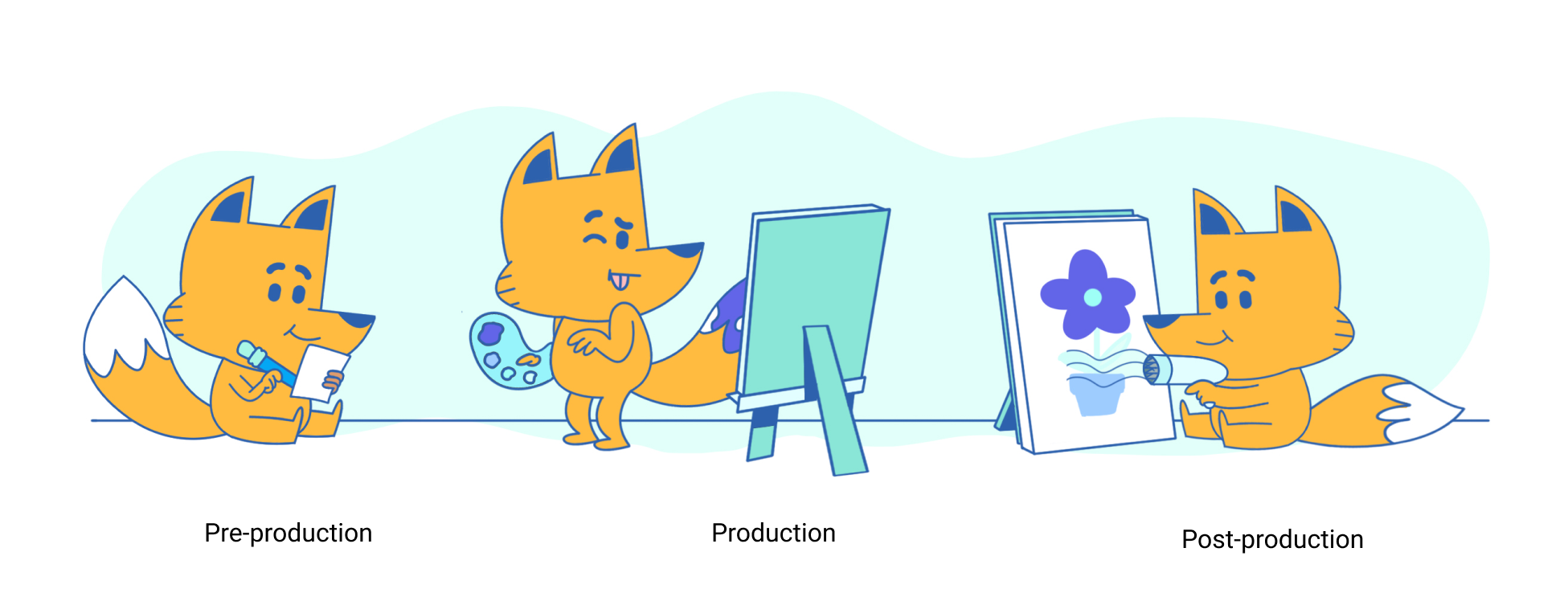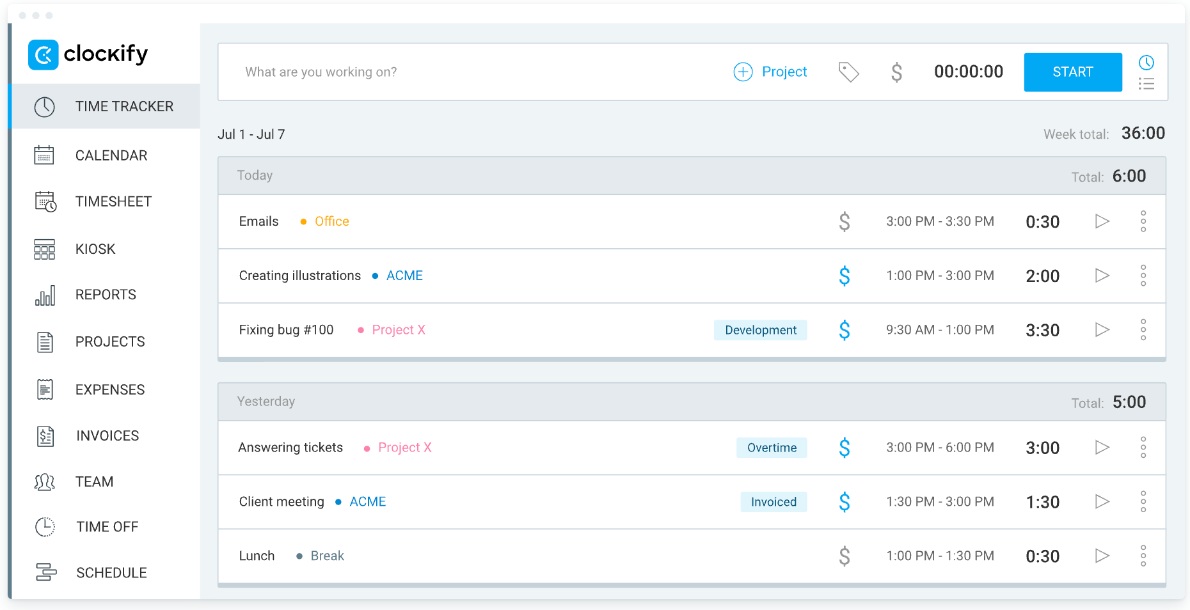When was the last time you finished a project without doing overtime or rushing to meet the deadline?
Or every bigger assignment seems too complex to tackle, and has so many moving parts, that you don’t know where to start?
What if we could help you find a new approach? One where as soon as you finish the first task, others topple over with ease.
In this article, we’ll show you how to maximize your productivity during projects, and how to breeze through them without missing any deadlines. And all that by breaking a project down into tasks.
Table of Contents
In what ways can you break down a project?
The way you break down projects into tasks will largely depend on the type of project you’re doing. As a rough estimate, there are three ways to go about this:
- Breaking down into phases – eg. software development;
- Breaking down into categories – eg. planning a conference (catering, photographer, speakers, etc.);
- Breaking down into parts – eg. cleaning your house room by room.
However, not every project is clear cut, and a lot of them will be in-between these categories. Which is why we can look at the process itself and make custom project breakdowns to suit our individual needs.
How to break down a project into tasks
The whole process consists of identifying what tasks that make up your project, their dependencies on one another, and the time constraints. Once we know all three, we can make up a solid breakdown process.
In short, these are the steps you need to take to break down projects into tasks:
- Identify the tasks
- Look at task dependencies
- Set milestones
Step 1: Identify the tasks
This seems redundant at first, but think about it: How do you know what constitutes a task?
In our personal life, it’s simple: “make your bed in the morning” is a task. “Answer the morning emails” is another one.
However, professionally, the lines get a little more blurred. As it turns out, there can be thousands of different tasks with different dependencies. How will you know which ones get priority? How do you implement them in a smooth-flowing work schedule?
Here are a few tips on how to recognize and form tasks:
Identify tasks by their completion time
You can identify tasks based on the time it takes to complete them.
Usually, you’ll want to break down a project into tasks that’ll be finished within a reasonable timeframe. The longer they draw out, the more the deadlines and overall productivity suffer. This is also a good indicator of the task being too big or complex.
There are several commonly used guidelines to determine how long a task should take:
- “Rule of twos” – no task should be worked on shorter than two days, or longer than two weeks
- The 80-hour rule – no task, assignment, or activity should take longer than 80 hours
- Three-point estimation – assess the length of the task based on the best/worst/most likely case scenario
These three guidelines are just scratching the surface. Task completion times will vastly depend on the industry you’re in, project type, its overall complexity and much more. One thing you can do is make an internal assessment with your team for each task and go from there.
If you have time tracking software like Clockify when a workweek is up, you can look over the time estimates, actual times spent on the tasks and use that information to make more accurate assessments in the planning stages.
Identify tasks by their importance
If you’re having trouble identifying tasks, start out by asking which steps need to be performed for the project to be finished?
Breaking down a project according to its crucial tasks helps you divide it into larger chunks first. It also automatically identifies milestones (which we’ll talk about later) and gives a headstart on breaking down those chunks into bite-sized tasks.
For example, within the software development industry, it’s well known that task breakdown relies on crucial milestones that need to be passed in order for the software to be considered finished.

Identify tasks with input from the team
If you’re managing a team and don’t want to make your own rough estimates for fear of mistaking, consult your teammates.
After all, they’ll have the best insight into which tasks are crucial for the project, as well as the time required to finish them.
A designer, for example, knows how much time it’ll take for a logo to be created as well as the steps needed to consider the task done (research, color exploration, concepts, test logos, etc).
Similarly, a QA analyst will know how long it takes to write up bug reports and how many in a day she can do.
When in doubt, ask your teammates.
Identify tasks by the “definition of done”
Lastly, you can identify tasks based on the so-called “definition of done”. Instead of trying to finish a task perfectly, you work on it until it is in a good enough state to be checked off. This practice is especially common within the Agile model, in software development.
But, this notion can be expanded to other industries as well.
The “definition of done” is a set of agreed-upon criteria between team members when a task is done well enough to be considered finished/ready. This means you can identify tasks based on the amount of work required to achieve the best result without having to go overboard.
This method addresses task identification by setting clear work boundaries.
Step 2: Look at task dependencies
The second step in project breakdowns is to find out which ones take priority over others. For that, we need to look at the way the tasks correlate with each other.
For a simple example, if you’re asked to paint a wall, you know that you need to buy paint first.
The same principle applies to your task scheduling. You must identify tasks that are dependent on each other’s completion. This is crucial for several reasons:
- Helps identify scheduling issues and possible workflow problems;
- Makes for easier monitoring, troubleshooting, and managing;
- Allows you to find opportunities for speeding up or slowing down of the workflow
Step 3: Set milestones
Once you’ve broken down the project into tasks, you need to create a framework for them. This is where the milestones come in.
When you’re planning a road trip, you chart out where you should be the next day, three days from now, and a week later. Then within that schedule, you plan out sights to see, look for gas stations and motels along the way.
It’s the same for projects.
There should be a milestone depending on your overall completion deadline: every week, every two weeks, every month, etc. Using that timeframe, you can sort the tasks and see if any of them are too big or too small. Milestones give another perspective on the schedule, shedding new light on how you formulated the tasks.
This does wonders for task identification, as it’s not uncommon to wrongly assume how long a task will take. For the same reason you can also first set the milestones, and then identify individual tasks.
Best ways to tackle tasks
This final section is dedicated to how you can handle your projects and tasks effectively. The methods listed here will add the final touch to your project breakdown and ultimately test out if your task identification is on point.
Use them as a way to perfect your task management skills and improve.
Time blocking keeps your workflow on track
This is a method in which you define the amount of time it’ll take to finish each task, and then make a schedule according to these times. As great as this works for personal time management, it’s also a tremendous help when organizing project work. It’s very simple to follow:
- You compile all of the tasks for that day or week;
- Determine the timeframe for each task and create a schedule;
- Work on tasks by following the schedule and keep to the time limit.
The second step can go even smoother if other team members provide more experienced input for times related to their field of expertise.
For example, a QA tester will know more precisely than a project manager how long it will take for her to write up, say, five reports. Similarly, the designer knows how much time goes into logo design (the research, concepts, and finding a style).
However, sometimes a project requires more flexibility, and you simply can’t keep to a very tight schedule. To ensure your whole schedule doesn’t go off the rails or breaks through deadlines, just keeping two or three steps planned out ahead will be enough.
Project templates save you time
When you have a lot of the same or similar projects in a row, what you want is to set up a project template.
After breaking it down into individual tasks and milestones for the first time, it’s smarter to keep a template, as it saves time and effort. Not to mention that your team can simply dive into work immediately.
In Clockify, you have the option of making a custom project template (or several), which you can save for later use across various projects you might be handling.

Time management skills help overall
On our blog, we’ve already discussed the importance of time management. Honing this skill, in particular, helps your task and project management in several ways:
- Teaches you how to get more done in less time;
- Makes you better at forming schedules around tasks;
- Helps cushion stress and prepares for work under pressure;
- Guides your team to form a much better work-life balance.
Overall, time management is an indispensable skill to obtain. And if you can employ some time management apps or desktop software to aid you with it, all the better.
Clockify breaks complex projects into simple tasks
If you want to complete complex projects on time, organizing them into smaller and more manageable tasks can do wonders.
You can do this in many ways, but the best way is to use a task-tracking app like Clockify!
Clockify is free task-tracking software that allows you to create projects and divide them into minor tasks. The app’s Time tracker allows you to track the time spent on every task and analyze your performance.

You can write down tasks and projects by clicking the plus sign (+ Project). From here, you can view all your existing projects and tasks — or add new ones.
Clockify also features its powerful Calendar, which allows you to schedule your activities in simple time blocks. To time block your tasks, simply do the following:
- Click on an empty time slot in the Calendar,
- Describe what project you are working on, and
- Add a time period.

With Clockify, you don’t have to worry about complex projects. Instead, you can break them down into smaller tasks and focus on each task individually.
Finally, you can have a dedicated project management app with a plethora of project management features, together with Clockify and a team chat app for better collaboration. Buy all 3 apps in the CAKE.com Bundle and save 53% on subscriptions.



